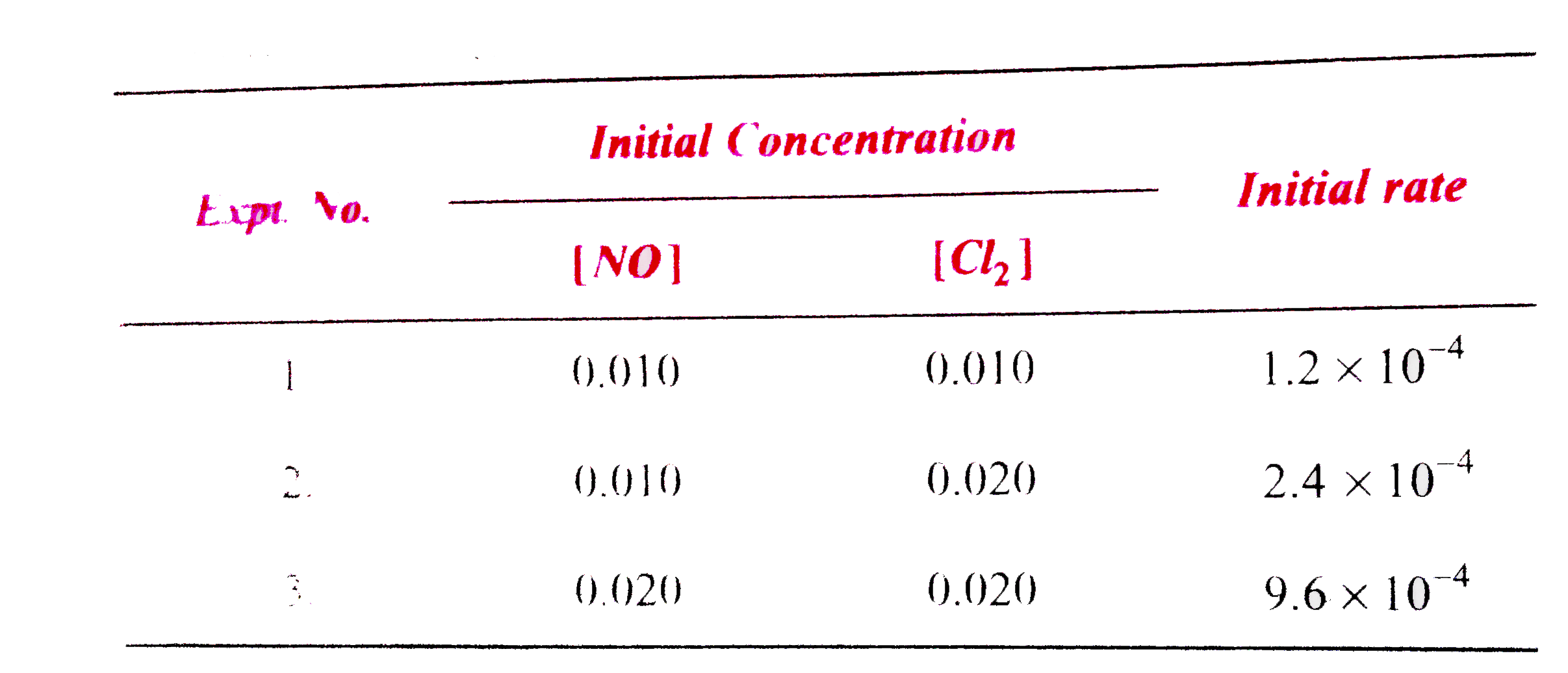The following rate data were obtained at 303K for the following reaction:
2A+B→C+D

What is the rate law? What is the order with respect to each reactant and the overall order? Also calculate the rate constant and write its units.
Let the order of the reaction with respect to A be x and with respect to B be y .
Therefore , rate of the reaction is given by ,
Rate = k[A]x[B]y
According to the question ,
6.0×10−3=k[0.1]x[0.1]y (i)
7.2×10−2=k[0.3]x[0.2]y (ii)
2.88×10−1=k[0.3]x[0.4]y (iii)
2.40×10−2=k[0.4]x[0.1]y (iv)
Dividing equation (iv) by (i) , we obtain
2.40×10−26.0×10−3=k[0.4]x[0.1]yk[0.1]x[0.1]y
⇒4=[0.4]x[0.1]x
⇒4=(0.40.1)x
⇒(4)1=4x
⇒x=1
Dividing equation (iii) by (ii) , we obtain
2.88×10−17.2×10−2=k[0.3]x[0.4]yk[0.3]x[0.2]y
⇒4=(0.40.2)y
⇒4=2y
⇒22=2y
⇒y=2
Therefore , the rate law is
Rate = k [A][B]2
⇒k=Rate[A][B]2
From experiment l , we obtain
k=6.0×10−3molL−1min−1(0.1molL−1)(0.1molL−1)2
6.0L2mol−2min−1
From experiment lll , we obtain
k=2.88×10−1molL−1min−1(0.3molL−1)(0.4molL−1)2
6.0L2mol−2min−1
From experiment IV , we obtain
k=2.40×10−2molL−1min−1(0.4molL−1)(0.1molL−1)2
=6.0L2mol−2min−1
Therefore , rate constant , K = 6.0L2mol−2min−1
Topper's Solved these Questions
- BOOK - NCERTCHAPTER - CHEMICAL KINETICSEXERCISE - Exercise1videos
CHEMICAL KINETICS
- BOOK - NCERTCHAPTER - CHEMICAL KINETICSEXERCISE - SOLVED EXAMPLE1videos
CHEMICAL KINETICS
- BOOK - NCERTCHAPTER - BIOMOLECULESEXERCISE - Exercise33videos
BIOMOLECULES
- BOOK - NCERTCHAPTER - CHEMISTRY IN EVERYDAY LIFEEXERCISE - Exercise32videos
CHEMISTRY IN EVERYDAY LIFE
Similar Questions
The following rate data were obtained at 303 K for the following reaction:
2A+B→C+D

What is the rate law? What is the order with respect to each rectant and the overall order? What are the units of the rate constant?View SolutionThe following initial rate data were obtained at 300K for the reactions:
2A+B→C+D

Deducethe rate law.View Solution
Knowledge Check
- Question 1 - Select One
A reaction of first order with respect to reactant A and second order with respect to reactant B. the rate law for the reaction is given by
ARate=k[A][B]2BRate =[A][B]2CRate =[A]2[B]DRate =k[A]0[B]2
The following rate data were obtained at 303K for the following reaction :
2A+B→C+D
Experiment[A]/mol L−1[B]/mol L−1Initial rate of formation of D/mol L−1−1minI0⋅10⋅16⋅0×10−3II0⋅30⋅27⋅2×10−2III0⋅30⋅42⋅88×10−1IV0⋅40⋅12⋅4×10−2
What is the rate law ? What is the order with respect to each reactant and the overall order ? Also calculate the rate constant and write its units.View SolutionThe following rate data were obtained at 303K for the following reaction :
2A+B→C+D
Experiment[A]/mol L−1[B]/mol L−1Initial rate of formation of D/mol L−1−1minI0⋅10⋅16⋅0×10−3II0⋅30⋅27⋅2×10−2III0⋅30⋅42⋅88×10−1IV0⋅40⋅12⋅4×10−2
What is the rate law ? What is the order with respect to each reactant and the overall order ? Also calculate the rate constant and write its units.View SolutionThe following results have been obtained during the kinetics studies of the reaction :
2A+B → C + D

Determine the rate law and the rate constant for the reaction.View SolutionThe following results have been obtained during the kinetic studies of the reaction:
2A+B→C+D

Determine the rate law and the rate constant for the reaction.View SolutionThe following data wer obtained for a given reaction at 300 K

Calculate by what factor the rate of catalyst reaction is increases ?View SolutionFor the reaction
2NO→2NOCl
at 300 K, following data are obtained:

Write rat law for the reaction. What is the order of the reaction? Also calculate the specific rate constant.View SolutionFor the first order thermal decomposition reaction, following data was obtained:

Calculate the rate constant.View Solution

